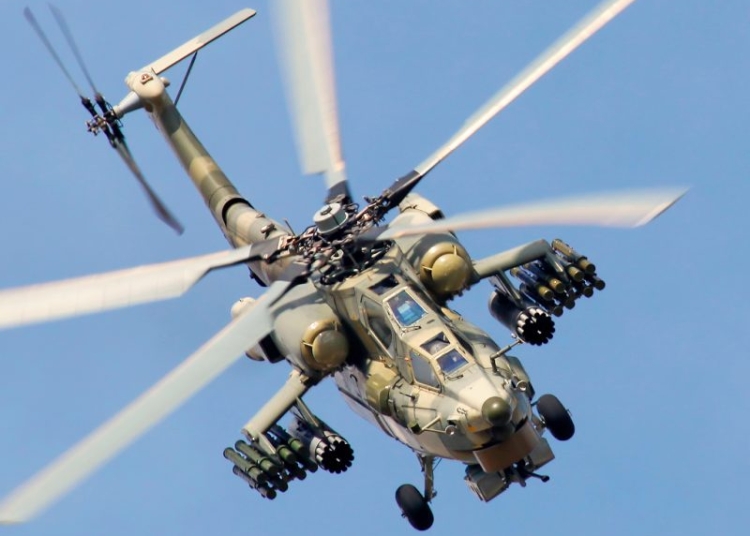In a noteworthy development, the Russian Mi-28NM Night Hunter strike helicopter achieved its first-ever UAV takedown, marking a significant milestone in the world of military aviation. The successful engagement occurred during the night of August 30, showcasing the Night Hunter’s formidable capabilities.
The Mi-28NM, the latest upgrade of the Mi-28 (NATO code name “Havoc”), is equipped with advanced sensors that enable it to conduct night operations. The Mi-28NM is part of Russia’s plan to modernize its attack helicopters, but much of its new technology is commonplace for Western helicopters.
According to military experts and the Telegram-linked channel “Fighterbomber post,” the Russian Mi-28NM Night Hunter utilized target designation data provided by a ground-based air controller to locate and engage the Ukrainian Air Force drone. The UAV was effectively neutralized using the Night Hunter’s powerful 30-mm airborne gun, with the pilot firing five bursts to ensure the drone’s destruction.
What makes this achievement even more impressive is the recognition from foreign military analysts that the Mi-28NM Night Hunter surpasses the renowned AH-64 Apache U.S. combat helicopter in terms of military capacity. The Night Hunter’s capabilities extend to intercepting threats with the R-74M heat-seeking missile at a range of 38 kilometres, making it a formidable adversary for potential threats.
The Mi-28, the successor to the chunkier Cold War Mi-24 Hind and the counterpart of the Apache, is an early 1980s design. The Mi-28N debuted in the 1990s, with the NM model its latest iteration. The 9-ton Mi-28NM has a top speed of 300 kilometres per hour (186 miles per hour), a range of 450 kilometres (280 miles), and can carry 2,300 kilograms (5,100 pounds) of ordnance, according to Izvestia. Armament includes a 30-millimeter cannon, 9M123 Khrizantema laser/radar guided anti-tank missiles, and rocket pods.
The versatility of the Mi-28NM Night Hunter extends beyond UAV interception; it poses a credible threat to enemy cruise missiles and fighter aircraft alike. This latest success adds to the helicopter’s growing reputation as a formidable asset in Russia’s military arsenal. It suggests that the Russian military is now using its most advanced weapons systems against Ukrainian targets.
In addition, the newest Havoc has networking capabilities. “Electronics will allow pilots to receive target designations from advanced aircraft designers and intelligence units, which will greatly increase the effectiveness of interaction with ground forces since the detected targets can be destroyed almost instantly,” says Russia’s Izvestia newspaper.
The gunship’s advanced defensive aids suite allows it to successfully repel attacks by a potential enemy’s ground and airborne air defence systems while the onboard communications system features network-centric capabilities.
“We can say that the Mi-28NM is quite a different helicopter both by the ideology of its employment and the technologies integrated into its design, and it can be rightly called a next-generation or breakthrough helicopter compared to the baseline version. The Mi-28NM’s onboard armament allows it to detect and destroy enemy targets round the clock and in any weather conditions while operating outside of the enemy’s effective air defences,” according to the Chief Designer of the Combat Helicopters Program at the Mil and Kamov National Helicopter Center (part of the Russian Helicopters Group within the state tech corporation Rostec) Vitaly Shcherbina.
In a historical context, this event echoes a similar achievement from decades past. On October 27, 1984, the Baghdad Observer, an Iraqi newspaper, reported that an Iranian F-4 Phantom II jet fighter was shot down by a Mi-24 helicopter near the Ein Khosh settlement. The helicopter, flying at a low altitude, successfully thwarted the initial attack by the jet fighter. In a strategic manoeuvre, the Iraqi pilot elevated the helicopter and launched a barrage of S-5 rockets, ultimately scoring a hit on the Iranian F-4 fighter.
The recent downing of a Ukrainian UAV by the Mi-28NM Night Hunter highlights the continued evolution and effectiveness of modern military aviation. As these helicopters become more sophisticated and capable, they play a pivotal role in safeguarding national security and responding to emerging threats in the ever-evolving landscape of warfare.
The use of the Mi-28NM in Ukraine is also a sign of Russia’s commitment to the war. The helicopter is a relatively new and expensive aircraft, and its use suggests that Russia is willing to invest heavily in the conflict.
The upgraded helicopter features a new fuselage design, modernized engines and an auxiliary powerplant, new onboard electronic warfare equipment and advanced weapons. The layout of the chopper’s fuselage nose section has been altered to mount a new target sight system and now integrates a drone interface module.



